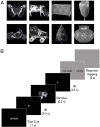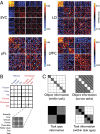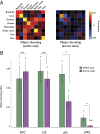Task context impacts visual object processing differentially across the cortex
- PMID: 24567402
- PMCID: PMC3956196
- DOI: 10.1073/pnas.1312567111
Task context impacts visual object processing differentially across the cortex
Abstract
Perception reflects an integration of "bottom-up" (sensory-driven) and "top-down" (internally generated) signals. Although models of visual processing often emphasize the central role of feed-forward hierarchical processing, less is known about the impact of top-down signals on complex visual representations. Here, we investigated whether and how the observer's goals modulate object processing across the cortex. We examined responses elicited by a diverse set of objects under six distinct tasks, focusing on either physical (e.g., color) or conceptual properties (e.g., man-made). Critically, the same stimuli were presented in all tasks, allowing us to investigate how task impacts the neural representations of identical visual input. We found that task has an extensive and differential impact on object processing across the cortex. First, we found task-dependent representations in the ventral temporal and prefrontal cortex. In particular, although object identity could be decoded from the multivoxel response within task, there was a significant reduction in decoding across tasks. In contrast, the early visual cortex evidenced equivalent decoding within and across tasks, indicating task-independent representations. Second, task information was pervasive and present from the earliest stages of object processing. However, although the responses of the ventral temporal, prefrontal, and parietal cortex enabled decoding of both the type of task (physical/conceptual) and the specific task (e.g., color), the early visual cortex was not sensitive to type of task and could only be used to decode individual physical tasks. Thus, object processing is highly influenced by the behavioral goal of the observer, highlighting how top-down signals constrain and inform the formation of visual representations.
Keywords: fMRI; object recognition; occipitotemporal cortex; top-down processing; vision.
Conflict of interest statement
The authors declare no conflict of interest.
Figures








Similar articles
-
Bottom-Up and Top-Down Factors Differentially Influence Stimulus Representations Across Large-Scale Attentional Networks.J Neurosci. 2018 Mar 7;38(10):2495-2504. doi: 10.1523/JNEUROSCI.2724-17.2018. Epub 2018 Feb 2. J Neurosci. 2018. PMID: 29437930 Free PMC article.
-
Task-Related Dynamic Division of Labor Between Anterior Temporal and Lateral Occipital Cortices in Representing Object Size.J Neurosci. 2016 Apr 27;36(17):4662-8. doi: 10.1523/JNEUROSCI.2829-15.2016. J Neurosci. 2016. PMID: 27122025 Free PMC article.
-
Disentangling Object Category Representations Driven by Dynamic and Static Visual Input.J Neurosci. 2023 Jan 25;43(4):621-634. doi: 10.1523/JNEUROSCI.0371-22.2022. Epub 2022 Dec 6. J Neurosci. 2023. PMID: 36639892 Free PMC article.
-
Category selectivity in human visual cortex: Beyond visual object recognition.Neuropsychologia. 2017 Oct;105:177-183. doi: 10.1016/j.neuropsychologia.2017.03.033. Epub 2017 Apr 2. Neuropsychologia. 2017. PMID: 28377161 Review.
-
[Feature Integration in Visual Working Memory].Brain Nerve. 2018 Jul;70(7):733-743. doi: 10.11477/mf.1416201074. Brain Nerve. 2018. PMID: 29997269 Review. Japanese.
Cited by
-
Neural Responses to Naturalistic Clips of Behaving Animals in Two Different Task Contexts.Front Neurosci. 2018 May 15;12:316. doi: 10.3389/fnins.2018.00316. eCollection 2018. Front Neurosci. 2018. PMID: 29867327 Free PMC article. No abstract available.
-
How Configural Is the Configural Superiority Effect? A Neuroimaging Investigation of Emergent Features in Visual Cortex.Front Psychol. 2017 Jan 23;8:32. doi: 10.3389/fpsyg.2017.00032. eCollection 2017. Front Psychol. 2017. PMID: 28167924 Free PMC article.
-
The spatiotemporal neural dynamics underlying perceived similarity for real-world objects.Neuroimage. 2019 Jul 1;194:12-24. doi: 10.1016/j.neuroimage.2019.03.031. Epub 2019 Mar 17. Neuroimage. 2019. PMID: 30894333 Free PMC article.
-
Parafoveal vision reveals qualitative differences between fusiform face area and parahippocampal place area.Hum Brain Mapp. 2024 Feb 15;45(3):e26616. doi: 10.1002/hbm.26616. Hum Brain Mapp. 2024. PMID: 38379465 Free PMC article.
-
Humans and Deep Networks Largely Agree on Which Kinds of Variation Make Object Recognition Harder.Front Comput Neurosci. 2016 Aug 31;10:92. doi: 10.3389/fncom.2016.00092. eCollection 2016. Front Comput Neurosci. 2016. PMID: 27642281 Free PMC article.
References
-
- Bar M, Ullman S. Spatial context in recognition. Perception. 1996;25(3):343–352. - PubMed
-
- Schyns PG, Rodet L. Categorization creates functional features. J Exp Psychol Learn. 1997;23(3):681–696.
MeSH terms
LinkOut - more resources
Full Text Sources
Other Literature Sources

